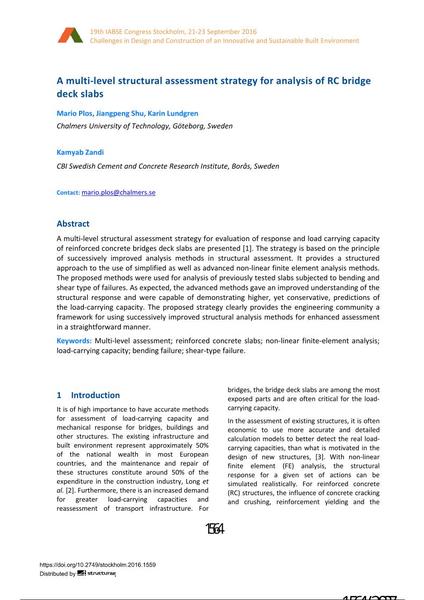A multi-level structural assessment strategy for analysis of RC bridge deck slabs

|
|
|||||||||||
Détails bibliographiques
| Auteur(s): |
Mario Plos
(Chalmers University of Technology, Göteborg, Sweden)
Jiangpeng Shu (Chalmers University of Technology, Göteborg, Sweden) Kamyab Zandi (CBI Swedish Cement and Concrete Research Institute, Borås, Sweden) Karin Lundgren (Chalmers University of Technology, Göteborg, Sweden) |
||||
|---|---|---|---|---|---|
| Médium: | papier de conférence | ||||
| Langue(s): | anglais | ||||
| Conférence: | IABSE Congress: Challenges in Design and Construction of an Innovative and Sustainable Built Environment, Stockholm, Sweden, 21-23 September 2016 | ||||
| Publié dans: | IABSE Congress Stockholm, 2016 | ||||
|
|||||
| Page(s): | 1564-1571 | ||||
| Nombre total de pages (du PDF): | 8 | ||||
| Année: | 2016 | ||||
| DOI: | 10.2749/stockholm.2016.1559 | ||||
| Abstrait: |
A multi-level structural assessment strategy for evaluation of response and load carrying capacity of reinforced concrete bridges deck slabs are presented [1]. The strategy is based on the principle of successively improved analysis methods in structural assessment. It provides a structured approach to the use of simplified as well as advanced non-linear finite element analysis methods. The proposed methods were used for analysis of previously tested slabs subjected to bending and shear type of failures. As expected, the advanced methods gave an improved understanding of the structural response and were capable of demonstrating higher, yet conservative, predictions of the load-carrying capacity. The proposed strategy clearly provides the engineering community a framework for using successively improved structural analysis methods for enhanced assessment in a straightforward manner. |
||||
